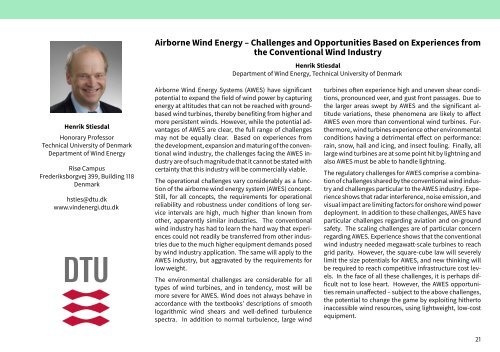Airborne Wind Energy Conference 2017 Book of Abstracts
Create successful ePaper yourself
Turn your PDF publications into a flip-book with our unique Google optimized e-Paper software.
<strong>Airborne</strong> <strong>Wind</strong> <strong>Energy</strong> – Challenges and Opportunities Based on Experiences from<br />
the Conventional <strong>Wind</strong> Industry<br />
Henrik Stiesdal<br />
Department <strong>of</strong> <strong>Wind</strong> <strong>Energy</strong>, Technical University <strong>of</strong> Denmark<br />
Henrik Stiesdal<br />
Honorary Pr<strong>of</strong>essor<br />
Technical University <strong>of</strong> Denmark<br />
Department <strong>of</strong> <strong>Wind</strong> <strong>Energy</strong><br />
Risø Campus<br />
Frederiksborgvej 399, Building 118<br />
Denmark<br />
hsties@dtu.dk<br />
www.vindenergi.dtu.dk<br />
<strong>Airborne</strong> <strong>Wind</strong> <strong>Energy</strong> Systems (AWES) have significant<br />
potential to expand the field <strong>of</strong> wind power by capturing<br />
energy at altitudes that can not be reached with groundbased<br />
wind turbines, thereby benefiting from higher and<br />
more persistent winds. However, while the potential advantages<br />
<strong>of</strong> AWES are clear, the full range <strong>of</strong> challenges<br />
may not be equally clear. Based on experiences from<br />
the development, expansion and maturing <strong>of</strong> the conventional<br />
wind industry, the challenges facing the AWES industry<br />
are <strong>of</strong> such magnitude that it cannot be stated with<br />
certainty that this industry will be commercially viable.<br />
The operational challenges vary considerably as a function<br />
<strong>of</strong> the airborne wind energy system (AWES) concept.<br />
Still, for all concepts, the requirements for operational<br />
reliability and robustness under conditions <strong>of</strong> long service<br />
intervals are high, much higher than known from<br />
other, apparently similar industries. The conventional<br />
wind industry has had to learn the hard way that experiences<br />
could not readily be transferred from other industries<br />
due to the much higher equipment demands posed<br />
by wind industry application. The same will apply to the<br />
AWES industry, but aggravated by the requirements for<br />
low weight.<br />
The environmental challenges are considerable for all<br />
types <strong>of</strong> wind turbines, and in tendency, most will be<br />
more severe for AWES. <strong>Wind</strong> does not always behave in<br />
accordance with the textbooks’ descriptions <strong>of</strong> smooth<br />
logarithmic wind shears and well-defined turbulence<br />
spectra. In addition to normal turbulence, large wind<br />
turbines <strong>of</strong>ten experience high and uneven shear conditions,<br />
pronounced veer, and gust front passages. Due to<br />
the larger areas swept by AWES and the significant altitude<br />
variations, these phenomena are likely to affect<br />
AWES even more than conventional wind turbines. Furthermore,<br />
wind turbines experience other environmental<br />
conditions having a detrimental effect on performance:<br />
rain, snow, hail and icing, and insect fouling. Finally, all<br />
large wind turbines are at some point hit by lightning and<br />
also AWES must be able to handle lightning.<br />
The regulatory challenges for AWES comprise a combination<br />
<strong>of</strong> challenges shared by the conventional wind industry<br />
and challenges particular to the AWES industry. Experience<br />
shows that radar interference, noise emission, and<br />
visual impact are limiting factors for onshore wind power<br />
deployment. In addition to these challenges, AWES have<br />
particular challenges regarding aviation and on-ground<br />
safety. The scaling challenges are <strong>of</strong> particular concern<br />
regarding AWES. Experience shows that the conventional<br />
wind industry needed megawatt-scale turbines to reach<br />
grid parity. However, the square-cube law will severely<br />
limit the size potentials for AWES, and new thinking will<br />
be required to reach competitive infrastructure cost levels.<br />
In the face <strong>of</strong> all these challenges, it is perhaps difficult<br />
not to lose heart. However, the AWES opportunities<br />
remain unaffected – subject to the above challenges,<br />
the potential to change the game by exploiting hitherto<br />
inaccessible wind resources, using lightweight, low-cost<br />
equipment.<br />
21


